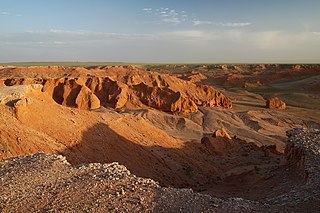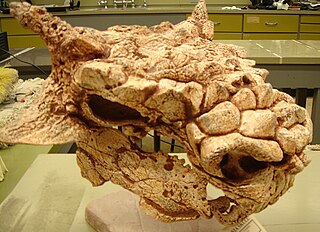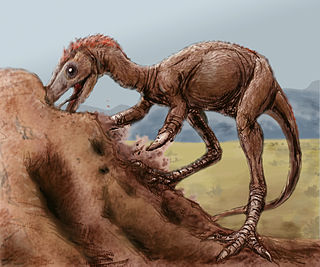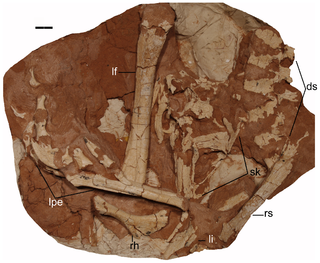
Velociraptor is a genus of small dromaeosaurid dinosaurs that lived in Asia during the Late Cretaceous epoch, about 75 million to 71 million years ago. Two species are currently recognized, although others have been assigned in the past. The type species is V. mongoliensis, named and described in 1924. Fossils of this species have been discovered in the Djadochta Formation, Mongolia. A second species, V. osmolskae, was named in 2008 for skull material from the Bayan Mandahu Formation, China.

Shuvuuia is a genus of bird-like theropod dinosaur from the late Cretaceous period of Mongolia. It is a member of the family Alvarezsauridae, small coelurosaurian dinosaurs which are characterized by short but powerful forelimbs specialized for digging. The type species is Shuvuuia deserti, or "desert bird". The name Shuvuuia is derived from the Mongolian word shuvuu (шувуу) meaning "bird".

Protoceratops is a genus of small protoceratopsid dinosaurs that lived in Asia during the Late Cretaceous, around 75 to 71 million years ago. The genus Protoceratops includes two species: P. andrewsi and the larger P. hellenikorhinus. The former was described in 1923 with fossils from the Mongolian Djadokhta Formation, and the latter in 2001 with fossils from the Chinese Bayan Mandahu Formation. Protoceratops was initially believed to be an ancestor of ankylosaurians and larger ceratopsians, such as Triceratops and relatives, until the discoveries of other protoceratopsids. Populations of P. andrewsi may have evolved into Bagaceratops through anagenesis.

Saurornithoides is a genus of troodontid maniraptoran dinosaur, which lived during the Late Cretaceous period. These creatures were predators, which could run fast on their hind legs and had excellent sight and hearing. The name is derived from the Greek stems saur~ (lizard), ornith~ (bird) and eides (form), referring to its bird-like skull.

Byronosaurus is a genus of troodontid dinosaur from the Late Cretaceous Period of Mongolia.

Archaeornithoides is a genus of maniraptoran theropod dinosaur of the Late Cretaceous of Mongolia.

Bagaceratops is a genus of small protoceratopsid dinosaurs that lived in Asia during the Late Cretaceous, around 72 to 71 million years ago. Bagaceratops remains have been reported from the Barun Goyot Formation and Bayan Mandahu Formation. One specimen may argue the possible presence of Bagaceratops in the Djadochta Formation.
Kuru is a genus of dromaeosaurid theropod from the Late Cretaceous Barun Goyot Formation of Mongolia. The genus contains only a single species, the type species Kuru kulla, which is known from a fragmentary skeleton including a partial skull.

Citipati is a genus of oviraptorid dinosaur that lived in Asia during the Late Cretaceous period, about 75 million to 71 million years ago. It is mainly known from the Ukhaa Tolgod locality at the Djadochta Formation, where the first remains were collected during the 1990s. The genus and type species Citipati osmolskae were named and described in 2001. A second species from the adjacent Zamyn Khondt locality may also exist. Citipati is one of the best-known oviraptorids thanks to a number of well-preserved specimens, including individuals found in brooding positions atop nests of eggs, though most of them were initially referred to the related Oviraptor. These nesting specimens have helped to solidify the link between non-avian dinosaurs and birds.

Sinovenator is a genus of troodontid dinosaur from China. It is from the early Cretaceous Period.

The Djadochta Formation is a highly fossiliferous geological formation situated in Central Asia, Gobi Desert, dating from the Late Cretaceous period, about 75 million to 71 million years ago. The type locality is the Bayn Dzak locality, famously known as the Flaming Cliffs. Reptile and mammal remains are among the fossils recovered from the formation.

Tsaagan is a genus of dromaeosaurid dinosaur from the Djadokhta Formation of the Late Cretaceous of Mongolia.

Mahakala is a genus of halszkaraptorine theropod dinosaur from the Campanian-age Upper Cretaceous Djadokhta Formation of Ömnögovi, Mongolia. It is based on a partial skeleton found in the Gobi Desert. Mahakala was a small dromaeosaurid, and its skeleton shows features that are also found in early troodontids and avialans. Despite its late appearance, it is among the most basal dromaeosaurids. Its small size, and the small size of other basal deinonychosaurians, suggests that small size appeared before flight capability in birds. The genus is named for Mahakala, one of eight protector deities (dharmapalas) in Tibetan Buddhism.

Minotaurasaurus is a monospecific genus of ankylosaurid dinosaur that lived in Mongolia during the Late Cretaceous in what is now the Djadochta Formation. The type and only species, Minotaurasaurus ramachandrani, is known from two skulls, a cervical vertebra and a cervical half ring. It was named and described in 2009 by Clifford Miles and Clark Miles. The first fossils of Minotaurasaurus were illegally exported out of Mongolia.It has been suggested to be a synonym of Tarchia but more recent publications consider it as a distinct genus.

The Bayan Mandahu Formation is a geological unit of "redbeds" located near the village of Bayan Mandahu in Inner Mongolia, China Asia and dates from the late Cretaceous Period. Laid down in the Campanian, it is dated somewhat uncertainly to between 75 and 71 mya.

Kol is an extinct genus of coelurosaurian theropod dinosaur from the Late Cretaceous of Mongolia. The type and only species is Kol ghuva. The type specimen was excavated from the Ukhaa Tolgod locality of the Djadochta Formation, dating to about 75 million years ago. It is believed to have been about twice the size of the contemporaneous Shuvuuia. However, unlike Shuvuuia, which is known from many well preserved specimens, and although Ukhaa Tolgod has been thoroughly explored, Kol is known only from one complete foot, suggesting that it must have been relatively rare in that ecosystem.

Linheraptor is a genus of dromaeosaurid dinosaur which lived in what is now China in the Late Cretaceous. It was named by Xu Xing and colleagues in 2010, and contains the species Linheraptor exquisitus. This bird-like dinosaur was less than 2 m (6.5 ft) long and was found in Inner Mongolia. It is known from a single, nearly complete skeleton.
Aiolosaurus is an extinct genus of monitor lizard from the Late Cretaceous of Mongolia. The type and only species, Aiolosaurus oriens, was named in 2000 from Ukhaa Tolgod, a rich fossil site in the Campanian-age Djadochta Formation.

Linhevenator is a genus of short-armed troodontid theropod dinosaur from the Late Cretaceous (Campanian) Bayan Mandahu Formation of Bayan Mandahu, Inner Mongolia, China.

Papiliovenator is a genus of troodontid theropod dinosaur from the Bayan Mandahu Formation of Inner Mongolia, China. The type and only species is Papiliovenator neimengguensis.



















